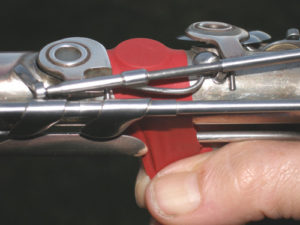
Everyone wants their pads to have a good seal so that their flute will have good tone. Flute technicians strive to find a good seal and we sometimes use instruments with air pressure or vacuum to test for leakage. But not everyone knows that you can have a perfect seal and still produce bad tone. An easy way to prove this is to remove a key and cover one of the toneholes near the head joint with a strip of rubber balloon (see photo). Cut a piece of balloon and get a helper to wrap the thin rubber over the tonehole & around the flute body so that there is no air leakage. The balloon material holds a perfect seal that will last all day long. Now close all the remaining keys to play middle D and blow a note without touching any part of the balloon that is stretched over the tonehole and you will get a big surprise – the tone is so bad that its not even musical or in tune. How can this be? Its because the pulsating air that makes sound is alternately pushing and pulling at the balloon material, causing it to flex in sympathy with the frequency of the note that is being played. Understand that when the air flexes the thin rubber inwards and outwards it is exactly the same as if air is leaking past a tonehole rim – the air is changing volume at the tonehole – energy is being lost pushing and pulling the balloon instead of moving the air column back and forth in the flute tube to make good tone. The important thing to realize is that some pads can flex in the same way as the rubber balloon. Air pushes the pad in towards the cup and then pulls it back out slightly with each pulsation of air. This happens very rapidly with the frequency of each note – for example 440 cycles for the note “A”. The softer the pad the more energy is lost. Conventional bladderskin pads can flap back and forth in this manner – dulling the tone and even buzzing like a kazoo in extreme cases.
Now play the note again while pressing a finger over the thin rubber to keep it from flexing and notice that the tone is better once again because the thin rubber is no longer moving in sympathy with the air pulsations.
Pads must be soft in order to seal against the tonehole rim. So how do we resolve the problem of needing tone deadening soft pads in order to obtain a seal? JS Gold pads achieve this by stretching the skin tightly between inner and outer pad collars while at the same time having metal powder embedded into an ultra thin skin to harden the surface and make it more tone reflective. The stretched flat skin surface takes an instantaneous impression only when the pad is closed against a tonehole. Then it springs back and flattens instantly when the pad is released from the tonehole. In this way the pad surface can be stiff and flexible at the same time. The skin always stays taught (tighter and less stretchy than bladdderskin). Unlike other skinned pads, Gold pads have the skin bonded to the cushion and that eliminates the tone robbing skin flexing that occurs with all bladderskin pads. It makes for better sounding flutes as has been witnessed over and over again by players who have switched to Gold pads.
After sealing and tone quality comes the problem of pads sticking. Some have more problems than others due to their body chemistry (sugar building up on the pad skin). Stickiness gets worse with highly polished toneholes and slick/glossy pad skins. Stickiness is reduced when the pad skin and/or tonehole rim is slightly roughened. So we need some texture on the surface, but when the pad skin surface is rough there are tiny microscopic leaks at the tonehole. So we have to compromise between perfect sealing and stickiness.
If you have leveled the pads reasonably well and you want to hear what the flute would sound like if it had a perfect seal beyond what you will achieve with perfect shimming, then perform the test as described below.
To experience perfect sealing, close the keys and use a spray bottle to wet the inside of the flute body & pads with water until water drips out. Any left over micro leaks due to skin texture should now be sealed to perfection (according to a leak meter test). If your seal before adding water was adequate you will find no improvement in tone or in attack of notes such as low B.

